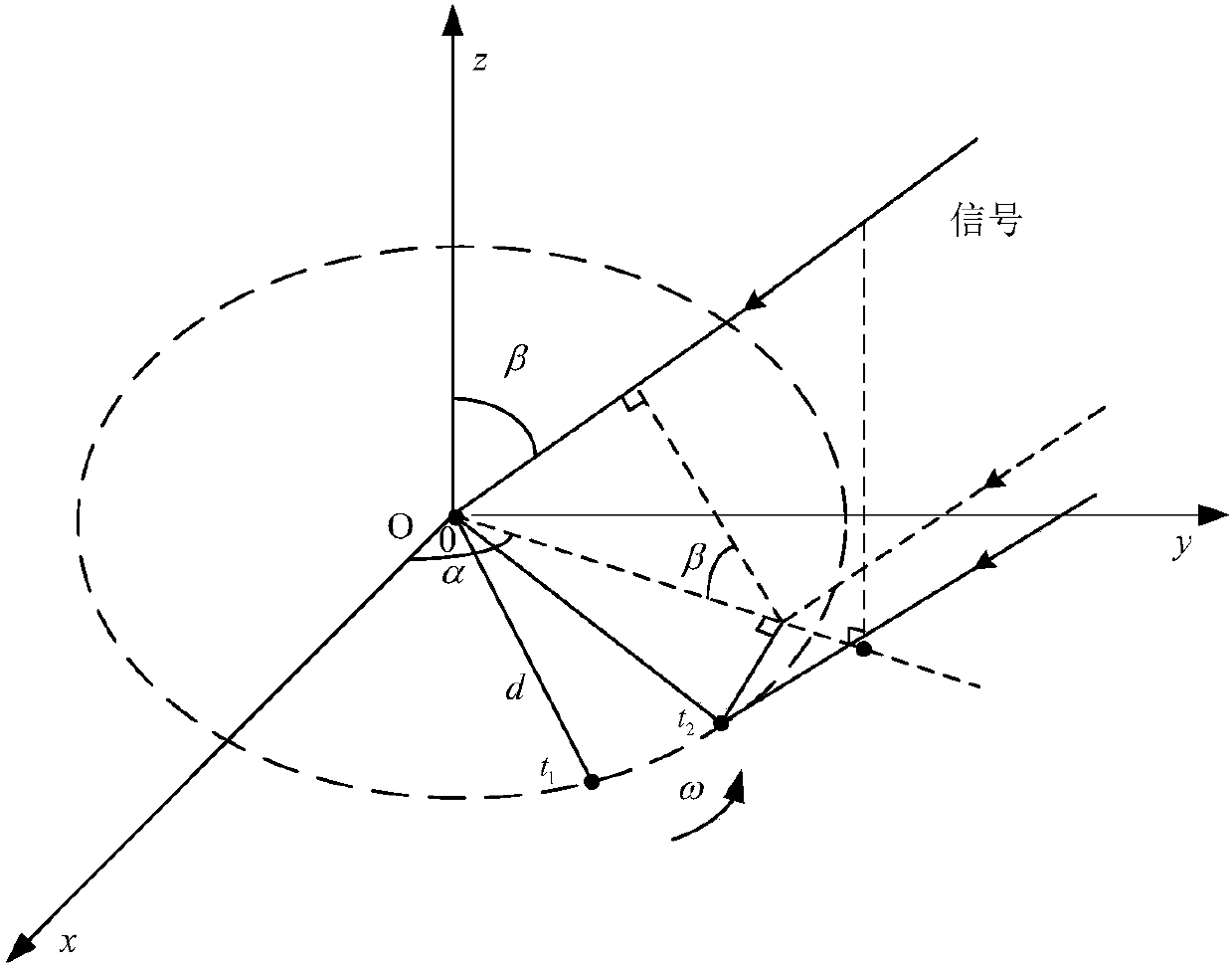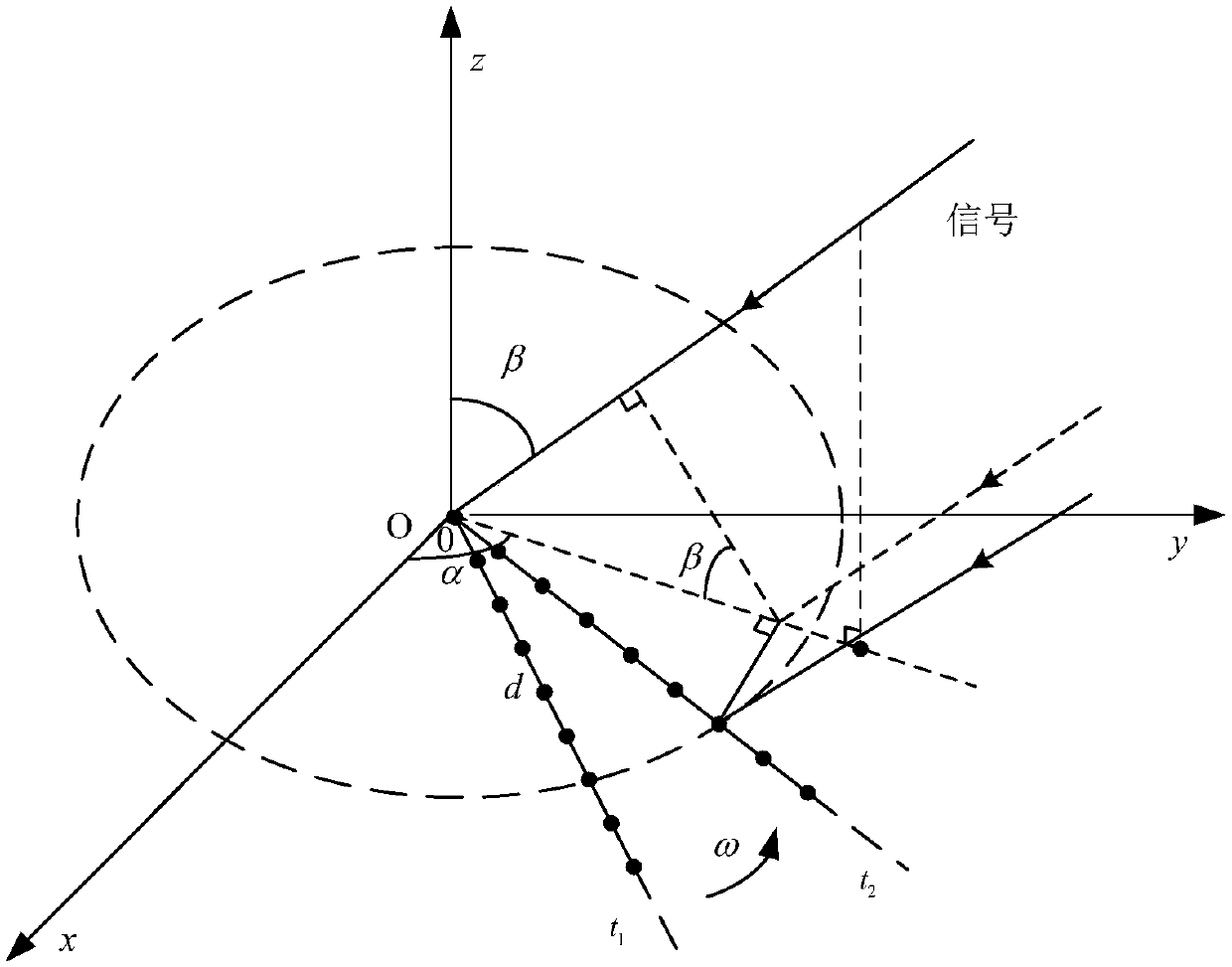Multi-objective angle ambiguity resolving method based on rotating interferometer
A rotating interferometer and angle ambiguity technology, applied in the field of data processing, can solve problems such as angle ambiguity, ambiguity, and algorithm failure, and achieve the effect of reducing the signal-to-noise ratio, reducing system complexity, and being easy to implement in engineering
- Summary
- Abstract
- Description
- Claims
- Application Information
AI Technical Summary
Problems solved by technology
Method used
Image
Examples
Embodiment 1
[0035]There are problems in the existing spaceborne passive direction finding technology: the traditional interferometer direction finding system can only estimate the two-dimensional angle information of a single target or multiple targets with frequency difference or time difference, and cannot estimate multiple targets working at the same frequency and at the same time For the two-dimensional angle information of the signal, the direction-finding system of the interferometer requires high accuracy of the phase difference between the array elements. In order to obtain an estimation result with a small error, a high signal-to-noise ratio is required; the traditional array direction-finding method can solve the multi-target problem , but to achieve the two-dimensional direction finding of the target, more array elements are required. Due to the load limitation, the number of array elements in the spaceborne array is small, and the aperture of the array is small, so the performan...
Embodiment 2
[0051] The multi-target angle defuzzification method based on the rotating interferometer is the same as in embodiment 1, wherein the phase difference matrix Φ(t) between the rotating interferometer array elements in step (1) is expressed as follows:
[0052]
[0053] Among them, N is the number of interferometer array elements, L is the number of signals in the space, d is the array element spacing, and d>>λ / 2. ω is the angular velocity of the rotating interferometer moving around the first array element in the xOy plane along the counterclockwise uniform circular motion, α 1 ,α 2 ,...,α L ,β 1 ,β 2 ,...,β L are the azimuth angle and elevation angle of each signal respectively, and the signal wavelength is λ. The sampling frequency is f s , the value of t is
[0054] The invention establishes a multi-channel rotating interferometer system. Compared with the two channels of the traditional rotating interferometer, multiple array element channels are added, and the ...
Embodiment 3
[0056] The multi-target angle defuzzification method based on the rotating interferometer is the same as that in Embodiment 1-2, wherein the interference data matrix X received by the multi-channel rotating interferometer at time t in step 2 0 (t), expressed as follows:
[0057]
[0058] Write the above formula as:
[0059] x 0 (t)=Φ(t)S(t)+N(t)
[0060] where x 1 (t), x 2 (t),...,x N (t) is the data received by each array element, s 1 (t),s2 (t),...,s L (t) is the carrier frequency of each space signal, n 1 (t),n 2 (t),...,n N (t) is the Gaussian white noise of each array element channel, which obeys the normal distribution N(0,σ 2 ). x 0 (t) is the received data vector obtained by array sampling, and Φ(t) is an N×L-dimensional phase difference change matrix. S(t) represents the spatial signal, and N(t) represents the noise matrix.
[0061] The present invention uses the mid-spectrum estimation processing method of the array signal in the processing method, s...
PUM
| Property | Measurement | Unit |
|---|---|---|
| Snr | aaaaa | aaaaa |
Abstract
Description
Claims
Application Information
 Login to View More
Login to View More - R&D
- Intellectual Property
- Life Sciences
- Materials
- Tech Scout
- Unparalleled Data Quality
- Higher Quality Content
- 60% Fewer Hallucinations
Browse by: Latest US Patents, China's latest patents, Technical Efficacy Thesaurus, Application Domain, Technology Topic, Popular Technical Reports.
© 2025 PatSnap. All rights reserved.Legal|Privacy policy|Modern Slavery Act Transparency Statement|Sitemap|About US| Contact US: help@patsnap.com



